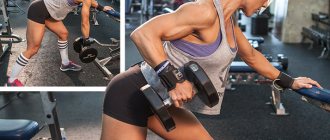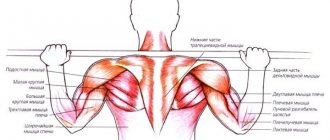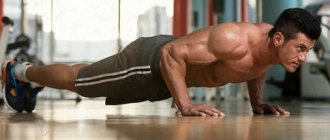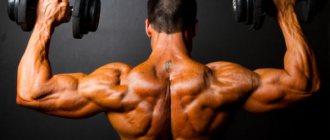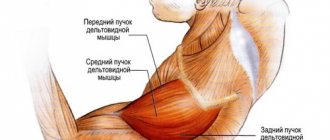Technique for lifting the barbell in front of you
Lifting the barbell in front of you - working muscles
To begin, pick up the barbell in your hands.
The grip should be straight. In this position, you need to lower your arms down. Your feet should be shoulder-width apart. The back is straight, the arms are bent at the elbows - this is the starting position. Raise the barbell up. The higher, the better - this will be facilitated by greater efforts of the front deltas. Lowering your arms should be done smoothly without jerking. It is best to perform in 3-4 sets of 12-15 repetitions.
Lifting the barbell with a standing reverse grip[edit | edit code]
Muscles working when lifting a barbell with a standing reverse grip: 1 - biceps;
2 - extensor carpi radialis longus; 3 - short extensor carpi radialis; 4 - extensor finger; 5 - extensor of the little finger; 6 - extensor carpi ulnaris Inventory
: barbell.
Core muscles
: extensor carpi, brachioradialis.
Additional muscles
: biceps.
Level of training
: average.
When lifting a barbell with a reverse grip, the main load falls on the brachioradialis and extensor carpi muscles.
Step 1
. Grasp the barbell with an underhand grip, shoulder-width apart. Stretch your arms down in front of you
Step 2
. Without moving your shoulders, bend your elbows and lift the barbell as close to you as possible.
Step 3
. Stop and return to the starting position.
Pay attention to…
When performing the exercise, pay attention to the following factors:
- The elbows should be bent, this way you can relieve tension from the elbow joints.
- Raising the barbell higher than your shoulders can produce a more acute load.
- Do not rush to increase the weight, first establish the correct technique, and then increase the load.
- The wider the grip, the greater the load on the deltoids, but this makes the exercise more difficult.
- Try not to swing; your efforts should be aimed at lifting the projectile using the deltas.
- If you have a problem back, use a special belt; it can perfectly protect the problem area from overload.
- You need to lift the barbell with a strong and powerful effort, lower it slowly, on the contrary, the emphasis needs to be focused on the negative phase. This will put more stress on the muscles.
Peculiarities
Raising your arms with dumbbells in front of you works the deltoid muscles. The maximum load is placed precisely on their front bundle. The middle delta is also involved. When performing the exercises, the following are pumped up:
- upper parts of the pectoral muscles;
- biceps;
- abdominal Press;
- trapezius and serratus muscles.
Due to the fact that stabilization of the core is required during training, the legs and back are also strained. The exercises are great for both beginners and professional athletes. Only those who have injured their shoulders during the year should refuse the training.
Lifting sports equipment in front of you brings great benefits to the body. By regularly performing such exercises, the following results can be achieved:
- strength indicators improve;
- the muscle tissue of the shoulders is strengthened, the risk of injury in this area is reduced;
- several groups of muscle tissue develop;
- shoulders become broad;
- the body takes on a sporty look.
Lifting heavy weights can cause injury. If dizziness or general weakness are observed, training should be stopped immediately.
Common mistakes and recommendations when performing dumbbell lifts
The most common mistake among people starting to work out in the gym is using dumbbells that are unreasonably large. The goal of the lift is to specifically and isometrically tense the target muscle group throughout the entire range of motion. To perform the exercise efficiently, it is enough to use dumbbells weighing 5-6 kg for men and 2-3 kg for women.
You should start practicing lifting dumbbells in front of you no earlier than the 3rd – 4th month after the start of training. This exercise should be included in the sports training program together with other basic movements. In this case, close attention must be paid not only to working muscles, but also to maintaining correct posture. If the athlete’s core muscles are poorly developed, then preference should be given to the option of performing from a sitting position.
How to properly lift dumbbells?
There are three main varieties of this exercise, which have approximately the same technique:
- classic version: you lift dumbbells in front of you with both hands at the same time;
- alternating option: you lift dumbbells with each hand in turn;
- Single dumbbell front raise: You hold one dumbbell with both hands and lift it in front of you.
First you need to choose the right dumbbell weight. If you are a beginner, you should not immediately lift heavy weights. First you need to strengthen the muscles of the shoulder girdle using light weights. Girls can use dumbbells weighing 2–3 kg. Men can start with 5-6 kg dumbbells. After a few sessions, when your deltoid muscles become stronger, you can choose the optimal weight, depending on your level of training and body weight. The anterior deltoid muscle gets tired very quickly, so don’t start with heavy weights right away.
Men can gradually increase the weight of dumbbells to 20 kg. The weight must be increased gradually (no more than 2 kg per workout). It is also important to understand the purpose of shoulder training. If you are working on increasing strength, then you need to take maximum weights for a minimum number of repetitions. If you are working to improve muscle definition, then you need to take weights with which you can perform a fairly large number of repetitions. Lifting two heavy dumbbells at the same time will be extremely uncomfortable, so when you are working with heavy weights, it is better to perform dumbbell lifts with each hand in turn.
Classic two-hand dumbbell lift
To perform this exercise, two types of dumbbell grips are used. The first one is palms down. The second is a neutral grip, with your palms facing each other. In most cases, a palms down grip is used.
- The starting position is standing. Feet shoulder-width apart, shoulders straightened and lowered down.
- Take dumbbells and place them in front of you at approximately hip level.
- Straighten your back, hands with dumbbells should not touch your hips. The arms should be slightly bent at the elbow joint;
- Raise your arm until it is parallel to the floor (this is approximately the level of your chin). The movement of raising the arms is performed while inhaling. The movement is performed only with the help of the shoulder muscles.
- The distance between your hands when lifting should be equal to the width of your shoulders. Make sure that your arms do not go to the sides when lifting.
- When the level of the chin is reached, you need to stay in this position for 1-2 seconds in order to maximally engage the muscles in the work.
- Smoothly lower your arms as you exhale and return to the starting position.
The video shows in more detail the technique of lifting dumbbells without using an inclined bench.
Video: Varieties and techniques for lifting dumbbells
Alternating lift option
The technique of performing alternating lifts is similar to the classic version. The only difference is that the arms with dumbbells are raised one by one. First, while inhaling, raise one hand and hold it for 1–2 seconds. As you exhale, lower your hand and repeat the exercise only with the second hand. The alternating option of lifting dumbbells in front of you is recommended when working with heavy weights.
Frontal raise of one dumbbell in front of you - working your shoulders
The frontal lift allows you to create a more isolated load on the front deltoids. For convenience, you can lift not a dumbbell, but a plate from a barbell of the appropriate weight.
- We take the starting position. We place our feet approximately shoulder-width apart, with our shoulders straightened and lowered down.
- We take one dumbbell with both hands, with the palms facing each other. Elbows can be bent.
- As you inhale, raise your hands to chin level and hold in this position for 1–2 seconds.
- As you exhale, lower your arms and return to the starting position.
Video: Swing dumbbells in front of you while standing (exercises not for barbells)
Basic shoulder exercises
Overhead Barbell Press and Chest Up Press
video - chest press
The barbell overhead press is one of the best exercises for building mass in the deltoid muscles of the shoulders.
Overhead barbell press
The main work is performed by the lateral and anterior delta bundles.
- sit on a bench, place the barbell on your shoulders;
- chest forward, shoulder blades together;
- grip slightly wider than shoulders - at the bottom point of the forearms perpendicular to the floor;
- press the barbell above your head until your arms are straightened, while your head tilts slightly forward;
- slowly lower the barbell to the base of your neck and repeat the exercise.
If you want to reduce the load on your spine, perform the exercise while sitting on a bench with a backrest.
Barbell Chest Press
The barbell chest press shifts the load to the front deltoids.
- When lowering the barbell to your chest, bring your elbows forward slightly;
- press the barbell up in the same way as when doing an overhead press - do not lean back or forward, your arms with the barbell are in the same plane as your body - perpendicular to the floor.
EZ-bar chin row
video - EZ-bar row to the chin
Chin rows are best performed with an EZ curved bar or dumbbells. This takes extra stress off your wrists, and they will be in a more natural position during the exercise.
- take the barbell with a grip slightly narrower than your shoulders;
- bend your elbows slightly;
- pull the barbell up using your shoulder muscles, trying to involve your biceps and triceps as little as possible;
- The shoulders are always higher than the forearms, the goal of the exercise is to raise the shoulders to parallel with the floor or slightly higher, and not to touch the chin with the barbell.
What muscles does lifting dumbbells in front of you use?
Raising dumbbells in front of you is a single-joint isolation exercise. It is widespread among men and women involved in sports. The high popularity of the athletic movement is due to its effectiveness and versatility. When lifting dumbbells in front of you, several large muscle groups are involved at once.
They bear 2 types of load:
- Static.
- Dynamic.
The main dynamic load falls on the anterior bundle of deltoid muscles. In this case, the rear and middle beams also perform work. They hold the humerus in its anatomically correct position. During the exercise, the pectoral muscles are included in the work. With a classic grip and a standard trajectory of arm movement, the upper pectoral bundle is loaded. When turning the dumbbells and bringing them together at the top point, the lower part of the pectoralis major muscle is isometrically tense.
The static load is distributed between the core muscles. During this athletic movement, the abdominals and long back extensors keep the torso upright. If the exercise is performed while standing, then the legs begin to actively engage in the work. The quadriceps, gluteal and hamstring muscles experience static load. The iliopsoas muscle is also involved in the work. One of the functions of which is to maintain the body in an upright position.
Nuances
The technique is heterogeneous and there are different options. The point of such variability is to strengthen in a particular case exactly those muscles that most need it.
Here are the varieties of such gymnastics:
- classic version;
- narrow grip;
- reverse grip.
The first method is described above. This is where you should start getting acquainted with this method. This is the most universal method, which will be easier for a beginner, at least if you correctly adjust the weight taking into account the person’s physical shape.
If you do it with a narrow grip, the muscles of the shoulders and back will be less pumped up and the muscles of the back and back will be strengthened, but the arms will become stronger. Before you start this variation, you should master the standard movements and do them for at least a month. When these become familiar, it is possible to begin alternative options.
A reverse grip will strengthen your biceps. In this case, the effectiveness for the back and shoulders will depend to a large extent on the width at which a person places his hands. But here you should not forget that with a reverse grip, sometimes the hands are more vulnerable, especially in people who usually use only a straight grip.
And it is important to do only a small number of repetitions and approaches with an underhand grip at first in order to observe the condition of your hands for at least a week
What can be replaced
The method is not unique, and it is possible to find an alternative
However, it is important to understand that lifting the barbell in front of you cannot be replaced with one exercise; you will need a complex of them.
Here's how to replace the technique:
- vertical row of dumbbells to the chest;
- pull-ups;
- horizontal pull-ups.
This is a minimum set, which together will replace lifting the barbell with almost straight arms. The seated dumbbell press will also help slightly (this will be useful for strengthening the biceps).
However, if such an opportunity exists, it is better to lift the barbell. This will give the most effective results. In addition, if the time factor is important, it is worth considering that this particular technique will strengthen and develop muscles quickly.
